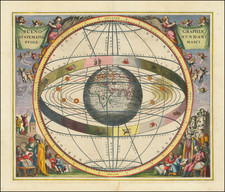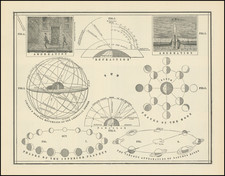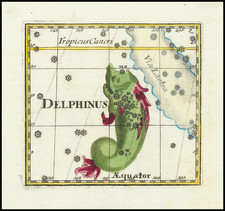"Early scientific view of the world"
An image showing seven different cross-sections of the earth, likely from Scherer's Atlas Novus Exhibens Orbem Terraqueum per Natureae Opera. The seven globes each relate to specific theories and observations from the earth. These are presented together in an elegant and simple manner.
The central image appears to include channels connecting oceans and volcanoes to the deep earth. This represents a theory put forth by Scherer's fellow Jesuit, Athanasius Kirchner, and discussed further below. Surrounding images include celestial observations, climatic observations, and what appear to be early attempts to create coordinate systems for the interior of the earth (Figure D). Figure L shows the positions of the equator, the tropics, and polar circles, choosing to represent each line by a mountain range. Figures K, P, and R builds on this by relating these various arcs to solar positions. Figure Q is enigmatic showing meridionol mountain ranges around the globe. This last figure is the only one not shown as a cross-section.
Athanasius Kirchner
Athanasius Kirchner was regarded as one of the leading thinkers of the 17th century. His work was diverse, ranging from him publishing treatises on biology to making technological advances. He is most well known for proposing the link between microbes and the plague. While some of his ideas were outlandish, such as the ones shown in this work, he is nevertheless regarded still regarded as a polymath with wondrous ideas.
Kirchner's ideas on geology were published in his Mundus Subterraneus, originally derived from his observations made in the south of Italy. After observing the tides, earthquakes, and, most notably, being lowered into a still-smoldering Vesuvius, Kirchner created a theory in which all these processes were connected by subterranean channels. Volcanoes were simply vents from the center of the earth, while earthquakes represented combustive processes. The tides were explained by flows in and out of caverns below the oceans.
This theory is portrayed in the central image. Interconnected channels lead down from oceans and volcanoes through subterranean seas and earthquake epicenters all the way down to a devilish, fiery figure at the core.









![Sphere Droite [and] Sphere Parallele](https://storage.googleapis.com/raremaps/img/small/6208.jpg)


![[Volcanos and the Subterranean World] Tabula Geographico-Hydrographica Motus Oceani, Currentes, Abyssos, Montes Igniuomos In Universo Orbe Indicans, Notat Haec Fig. Abyssos Montes Vulcanios](https://storage.googleapis.com/raremaps/img/small/95720.jpg)

![[Whoever is silent is Complicit -- Anti-Vietnam / Anti-American Poster] Vietnam: Sterminio | chi tace è complice](https://storage.googleapis.com/raremaps/img/small/89365.jpg)